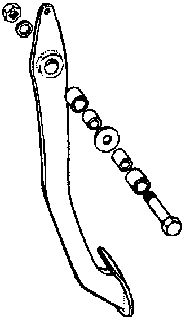The MGA With An Attitude
Worn Pedal BUSHING REPAIR - HT-110B
At 09:41 PM 12/18/2006 -0500, Daniel Hackney wrote:
>"I'd like to fix what I find to be an annoying trait .... the brake and clutch pedals each have a fair amount of side to side play. The play exists between the distance tube and the cross bolt, not between the distance tube and bushing. Using a caliper, I measured the bolt (3/8") to be 0.371" OD on average. The bolt doesn't have grooves in it or appear worn in any way. The existing distance tubes measured 0.385" and 0.380" ID. The two replacements that I purchased (from a reputable supplier) measured 0.392" and 0.387" ID. This hundredth is enough slop to translate to a lot of movement at the end of each pedal."
Remove clevis pins, pushrods, and the rubber pedal excluder. Remove the pivot bolt, and drop the pedals to the floor.


The bronze bushings are short and so are the distance tubes. The steel tubes are captured between the side brackets and a steel thrust washer in the center with the tight bolt so the steel tubes cannot move. The bolts are often undersize, and the tube bore can be oversize, but it doesn't matter as long as the bolt tightens up to hold the tubes securely at the ends so they cannot move.
The short bronze bushings are subject to cocking loads caused by sideways pedal forces. It does not take long for the bushings to wear enough to allow sideways pedal wobble up to about 1/4 inch. At about 1/4 inch of pedal wobble the steel thrust washer and side brackets come into play to relieve some of the cocking load on the bushings. If you are careful measuring things during assembly you can reduce the length of the inner steel distance tubes slightly so when the bolt is tightened it will minimize the side clearance for the pedals. This can help in the long run if you don't want to be constantly changing the bronze bushings.
As to fit of the bushing on the tube, it is common engineering practice to make the bushing with nominal bore size and make the shaft (tube in this case) about 0.002 inch undersize for working clearance. When the bushing is pressed tightly into the arm it may sometimes be reduced slightly in diameter, and/or the ends of the bushing might be slightly deformed during installation. If the bushing does not subsequently fit over the tube you can drive a standard size ball bearing through the bushing to burnish it back to correct size. The OD of the steel tube should be ground smooth and correct diameter for the bearing surface. If the tube OD is more than 0.002 inch smaller than the nominal size I would consider it to be a defective part.
It is a bit of a pain to R&R the pedals, but the bushings are otherwise cheap and easy to replace. I spent an extra half hour once measuring things and adjusting the length of the steel bearing tubes to minimize clearance for the thrust surfaces. This was time well spent, as I haven't felt the need to change the bushings again in a very long time.
Since someone asked, the center steel spacer washer is 1" OD x 3/8" ID x 1/4" thick. It needs to be this thick to make up the complete stack so the side brackets stay vertical and the bolt will tighten up without binding the pedals.
Reinstalling the pedals in the car is found on the next page.
|